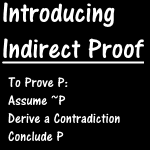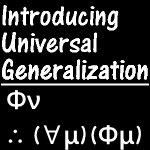This video completes a series on the rules of inference by covering the two types of dilemma: Constructive Dilemma and Destructive Dilemma. If you don’t understand any of the terminology used in this blog post, check out the earlier blog posts about this series on the rules of inference.
These two rules are extended forms of Modus Ponens and Modus Tollens. Constructive Dilemma is an extended form of Modus Ponens. Where the latter has one conditional with the affirmation of its antecedent, Constructive Dilemma has a conjunction of two conditional with the affirmation of at least one of their antecedents. This implies that at least one of the consequents is true.
Constructive Dilemma
(P ⊃ Q) & (R ⊃ S)
P v R
∴ Q v S
Destructive Dilemma is an extended form of Modus Tollens. Where the latter has one conditional with the denial of its consequent, Destructive Dilemma has the conjunction of two conditionals with the denial of at least one of their consequents. This implies that at least one of the antecedents is false.
Destructive Dilemma
(P ⊃ Q) & (R ⊃ S)
~Q v ~S
∴ ~P v ~R
The validity of Constructive Dilemma is demonstrated with a truth table in the video, and showing the validity of Destructive Dilemma with a truth table is left as an exercise. Intuitively, you should be able to understand them as valid if you understand how they work like Modus Ponens and Modus Tollens. For the same reason that these are valid, so are these:
(P ⊃ Q) & (R ⊃ S) & (T ⊃ U)
(P v R) v T
∴ (Q v S) v U
(P ⊃ Q) & (R ⊃ S) & (T ⊃ U)
(~Q v ~S) v ~U
∴ (~P v ~R) v ~T
No matter how many conditionals you string together in a single conjunction, you can infer that one of the consequents is true if you know that one of the antecedents is true, or you can infer that one of the antecedents is false if you know that one of the consequents is false. These longer arguments could also be shown to be valid with truth tables, but the truth tables would be large. With rules of inference and rules of replacement (yet to be explained), these arguments can be shown to be valid.
There are three ways to deal with a dilemma.
- You can go between the horns of a dilemma, which means to deny or question its disjunctive premise.
- You can grab a dilemma by its horns, which means to deny or question one of its conditionals.
- You can also create a counterdilemma, which keeps the antecedents of the old dilemma but replaces the consequents with ones that put the issue in a different light.
Details and examples are given in the video.



